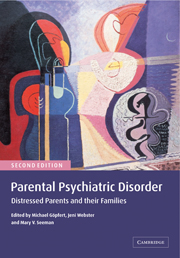Book contents
- Frontmatter
- Contents
- List of contributors
- Foreword
- Preface
- Part I Basic issues
- Part II Comprehensive assessment and treatment
- Part III Specific disorders: the impact on parent–child relationships
- 11 Schizophrenia and motherhood
- 12 When a parent suffers from an affective disorder: effect on the child
- 13 Alcohol and drug problems in parents: an overview of the impact on children and implications for practice
- 14 When mothers abuse drugs
- 15 Personality disorder in parents: developmental perspectives and intervention
- Part IV Specific treatments and service needs
- Part V Child-sensitive therapeutic interventions
- Part VI Models for collaborative services and staff training
- Afterword
- Index
- References
12 - When a parent suffers from an affective disorder: effect on the child
from Part III - Specific disorders: the impact on parent–child relationships
Published online by Cambridge University Press: 09 August 2009
- Frontmatter
- Contents
- List of contributors
- Foreword
- Preface
- Part I Basic issues
- Part II Comprehensive assessment and treatment
- Part III Specific disorders: the impact on parent–child relationships
- 11 Schizophrenia and motherhood
- 12 When a parent suffers from an affective disorder: effect on the child
- 13 Alcohol and drug problems in parents: an overview of the impact on children and implications for practice
- 14 When mothers abuse drugs
- 15 Personality disorder in parents: developmental perspectives and intervention
- Part IV Specific treatments and service needs
- Part V Child-sensitive therapeutic interventions
- Part VI Models for collaborative services and staff training
- Afterword
- Index
- References
Summary
Aetiology, prevalence and risk factors for depression in parents
By the year 2020, the World Health Organization estimates that clinical depression will be the second most common cause of morbidity (Murray & Lopez, 1996). Depression is widespread throughout adult life and, therefore, affects men and women who are parents. The negative effects of depression on children of all ages is well documented, but variations in timing, chronicity and the adverse social circumstances that often surround depression make the disaggregation of effects difficult. Some of the evidence that parental depression has adverse effects on children comes from studies where one or sometimes both parents have bipolar disorders, which is a vastly different picture from a more typical postnatal depression, treated, or as often not treated, in the community. In the more severe case, children can be affected by separation from parents because of parental hospitalization, and disruption to the children's daily lives as well as parental depression as such. Quick assessment and treatment, and special focus on children would seem advantageous, but in reality few controlled trials of the effectiveness of treatment for the children have been made. There is some evidence that even treatments which successfully relieve the maternal depression may not automatically improve the parent–child relationship. Much attention is given to postnatal depression, although the rate of depressed mood in pregnancy is already high, higher in fact than postpartum (Evans et al., 2001).
One to two women in every 10 will suffer a depressive disorder after childbirth.
- Type
- Chapter
- Information
- Parental Psychiatric DisorderDistressed Parents and their Families, pp. 172 - 184Publisher: Cambridge University PressPrint publication year: 2004
References
- 5
- Cited by

